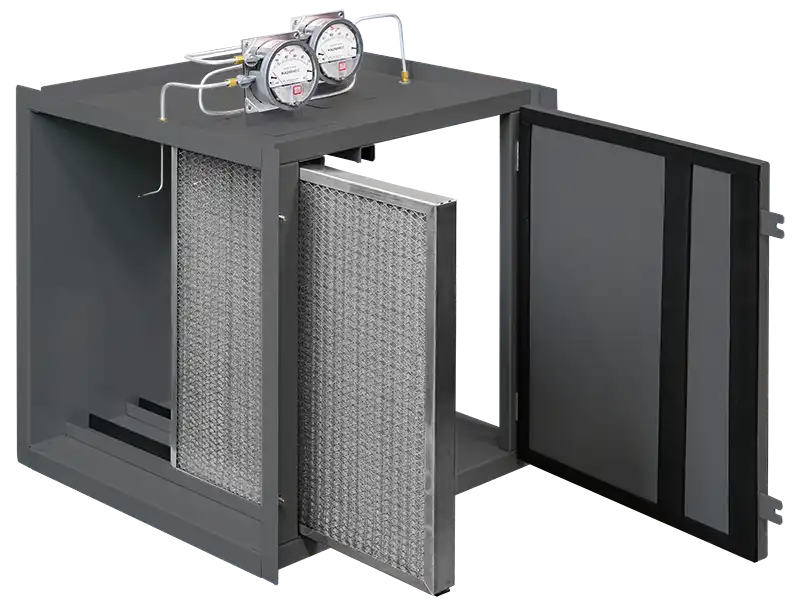Side Access Housing for ASHRAE Rated Air Filters
Side Access ASHRAE Housings

While many air filtration framing systems can be effective in standard HVAC setups, our Raptor Seal Side Access Housings are specifically designed for demanding environments where space constraints, accessibility, filtration performance, and system uptime are critical factors. These housings provide unique advantages that are necessary—not just convenient—in specific applications.
Our Raptor Seal Side Access Housings upgrade current HVAC systems by providing multiple stages of air filtration in the HVAC ductwork or Air Handling Units (AHUs) of the system. Unlike front-loading or hard-to-reach filter systems, Side Access Housings allow multiple stages of filters to be changed quickly from the side — increasing filtration options and efficiency and streamlining maintenance.
Below are the key scenarios where Side Access Housings are the superior (and often required) choice:
| Condition/Requirement | Use Side Access Housing? |
| Tight service space or limited filter access | ✅ Yes |
| Multi-stage, high-efficiency filtration need | ✅ Yes |
| Frequent filter changes required | ✅ Yes |
| Need to eliminate air bypass/leaks | ✅ Yes |
| High-volume or multi-zone HVAC systems | ✅ Yes |
| Regulatory compliance (ASHRAE, LEED, etc.) | ✅ Yes |
Refer to instruction steps 1-5 below to create a RaptorSeal Air Filter Housing to meet your specific application. Use the downloadable pdf below to fill out your order. Before We Begin – The Left or Right side of a housing is determined by facing the air entrance side of the housing. Here We Go!
1. Housing Dimensions and Airflow Capacities in CFM
- For New Construction Applications: The overall height and width of the housing is determined by the operating CFM required for the application. Please note there are 72 various housing configurations to choose from, yet many of them have similar CFM capacities, i.e., a 6,000 CFM housing is available as a 05H60W, 10H30W, 15H20W, 20H15W, or 30H10W.
- Choose the CFM airflow capacity (or capacities) from Selection Chart No. 1 that meet the application requirements.
- If only one CFM capacity is available, draw circles around the CFM and the corresponding Height and Width Codes.
- If more than one CFM capacity is available, decide which overall height and width dimensions are best suited to the application, and draw circles around the CFM and the corresponding Height and Width Codes.
- For Retrofit Applications: The existing plenum dimensions determine the overall height and width dimensions of the housing and the resulting total CFM available at 500 FPM.
- Choose the Height and Width dimensions from Selection Chart No. 1 that fits the existing plenum opening.
- Draw circles around the corresponding Height and Width Codes corresponding to the dimensions.
- Draw a circle around the resulting CFM located at the intersection of the Height and Width Codes.
2. Housing Location and Air Filter Specifications
- Place an “X” or a checkmark next to the location of the housing. The choices are Indoor or Outdoor.
- It is critical that the Air Filter Specifications are filled out completely.
- POS – Position of filter is stated as a number to identify the placement of the air filters, with the No. 1 position located at the air entrance side of the housing.
- CODE – The following codes identify the function of the air filters and help determine magnahelic gauge location. They are PRE (prefilter), INT (intermediate filter), or FIN (final filter)
- Air Filter Dimensions are described by H X W X D using nominal dimensions. When full and half size air filters are used, provide both sizes i.e., 24 X 24 X 4 / 12 X 24 X 4. When describing a headered air filter, include the overall depth of the filter including the header.
- HEADER – Answer Yes or No to describe filters with or without headers.
- INITIAL PD and FINAL PD – Initial and final pressure drop values, measured in water column (w.c.), are critical to ensure the housing meets the application requirements. Furthermore, the FINAL PD determines the correct pressure drop range for the magnahelic gauge.
- GAUGE* – Answer Yes or No for each filter that requires pressure drop monitoring.
3. Standard Options
Please note: the following five selections help make the housing part number. For each component, place an “X” or a checkmark next to the appropriate choice in the accompanying fillable pdf download.
-
- MATERIAL ALLOY
- FINISH
- DOORS
- INSULATION
- GAUGES
4. How to Determine Housing Depth
Conventions – Remember, RaptorSeal Air Filter Housings may be manufactured to any depth required, and this provides the design flexibility to create the best fitting, highest performing air filter housing for the application. The following design conventions describe the available choices to consider when creating a housing.
- The air entrance and air exit corner uprights are 3.00” deep.
- A 1.00” space between air filters is recommended when no magnahelic gauges are required.
- A 3.00” space between air filters is required to install a pitot tube when magnahelic gauges are specified.
- 1”, 2”, 4” and 6” thick nominal filters require a track depth of the same dimension specified using a whole number.
- A headered filter, while it requires a 1” deep track, must be identified by its overall depth to determine the total housing depth.
Depth Sizing – Determine the depth of the housing by applying the conventions above. Refer to the three samples on the Submittal Drawing to determine the minimum depth required based upon the air filter selection and magnahelic gauge requirements.
- Sample No. 1 – Holds a 12” deep headered filter and uses one magnahelic gauge. The housing depth = 18” (See illus. No. 1). The housing depth includes 6” for the uprights and 12” for the headered air filter for a total of 18”.
- Sample No. 2 – Holds a 2” prefilter, a 12” deep headered filter, and does not use a magnahelic gauge. The housing depth = 21” (See illus. No. 2). The housing depth includes 6” for the uprights, 2” for the prefilter, 1” for the space between filters (no magnahelic gauge), and 12” for the headered air filter. The housing depth = 21”.
- Sample No. 3 – Holds a 2” prefilter, a 4” secondary filter, and a 6” final filter, and uses 3 magnahelic gauges to monitor the pressure drop of each air filter. The housing depth = 24” (See illus. No. 3). The housing depth includes 6” for the uprights, 2” for the prefilter, 4” for the secondary air filter, 6” for the final filter and 2 X 3” for the spaces between the PRE and INT air filters and INT and FIN air filters. The housing depth = 24”.
5. Select Accessories
-
Why Side Access Housings Are Important Upgrades to HVAC Systems
-
Best Applications for Side Access Filter Housings
✅ Efficient Maintenance & Filter Access
Side Access Housings allow HVAC technicians to perform quick filter changes without disassembling ductwork or disrupting airflow. This is especially valuable in commercial HVAC systems where routine maintenance must be performed efficiently to avoid operational delays.
✅ Supports Multi-Stage Filtration
Many Side Access Housings are built with multiple filter tracks, making it easy to combine pre-filters, ASHRAE rated filters (MERV 8–13+), and final-stage filters like HEPA or ULPA. This multi-layered filtration removes a wide range of airborne contaminants and extends the life of higher-efficiency filters.
✅ Reduces Air Bypass & Enhances Indoor Air Quality
High-quality construction with gasketed access doors and gasket-sealed filter tracks to prevent air leakage and ensure that all air passes through the intended filters without disrupting airflow. This is essential for maintaining high indoor air quality and meeting ASHRAE ventilation standards in commercial buildings.
✅ Protects HVAC Equipment
By removing dust, allergens, and particulates before they reach sensitive HVAC components, Side Access Housings protect coils, fans, and ductwork from buildup, corrosion, and wear — helping prolong the life of the entire system.
Upgrade your commercial HVAC system with a Side Access Housing engineered for high-efficiency filtration, easy maintenance, and long-term performance. Constructed from heavy-duty galvanized steel or aluminum, this commercial HVAC filter housing is designed to securely hold ASHRAE rated filters in single-stage or multi-stage configurations.
Side Access Housings are ideal for a variety of high-demand commercial and industrial environments, including:
🏢 Office Buildings & Retail Centers – Easy access allows for quick service without disrupting tenants or business operations.
🏥 Hospitals & Healthcare Facilities – Supports ASHRAE-compliant filtration with multi-stage systems that meet strict air quality standards.
🏫 Educational Institutions – Maintains healthy airflow in schools and universities while simplifying maintenance.
🏭 Industrial Facilities & Warehouses – Handles large air volumes and protects against airborne contaminants in dust-heavy settings.
💾 Data Centers – Keeps equipment environments clean with high-efficiency filter housing that supports regular maintenance.
🛡️ Government & Military Buildings – Secure and accessible housing that supports high-performance filtration in mission-critical settings.
